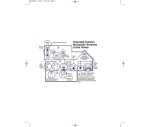Winter time to beware of carbon monoxide

Headaches, fatigue, irritability and confusion maybe a few words to describe the recent holidays but they are also symptoms of a potentially deadly poison.
Carbon monoxide (CO) is a gas that has no color and no smell and can easily go unnoticed.
CO poisons the body's blood cells and prevents them from receiving and using valuable oxygen. The gas is formed when something is not burned completely, or is burned in an enclosed space with insufficient airflow.
Other symptoms can be nausea and vomiting, shortness of breath, blurred vision, and dizziness. Dr. James Mowry, director of the Indiana Poison Center, warns that mild symptoms of carbon monoxide toxicity are similar to food borne illness or the flu. In severe incidents unconciousness and seizures can occur, resulting in death. Chronic exposure can produce headaches, weakness, and personality changes.
Dr. Mowry said, "Common sources can include poorly ventilated wood burning stoves or space heaters, automobile exhaust, or gas appliances that are not functioning properly."
Now that winter has finally come people are turning on space heaters and other appliances to heat their homes and businesses. Before turning them on, the Indiana Poison Center suggests an annual check of all units and for them to be cleaned or repaired if needed. Also all homes and businesses are suggested to have at least one carbon monoxide detector on each floor. In the home it is ideal to place the detector near all sleeping areas.
Greencastle Fire Chief Bill Newgent said, "The fire department has already made about a dozen responses to carbon monoxide poisoning this winter."
In the event of an emergency, Newgent said, everyone needs to leave a building and go outside, including pets. Then EMS needs to be called.
Upon receiving a call the fire department removes everyone from the building and then brings in their own detection equipment to determine the source. If you aerate a building full of CO gas before finding the source, it becomes difficult to detect the cause.
Some of the most common CO responses, Newgent said, "were having to do with a furnace, a cracked heat exchanger, a crack in a flume, or anything allowing gas to come back in to the house." In some cases it can be as simple as a birds nesting in a chimney preventing the gas to flow properly.
Currently the city of Greencastle does not give out or require carbon monoxide detectors. However many other cities' fire departments and other organizations like Riley's Children's Hospital do.
